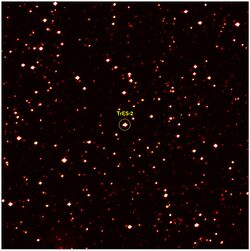Astronomy:GSC 03549-02811
GSC 03549-02811 (sometimes referred to as Kepler-1, or either TrES-2A or TrES-2 parent star in reference to its exoplanet TrES-2b)[7] is a yellow main-sequence star similar to the Sun. This star is located approximately 704 light-years away in the constellation of Draco. The apparent magnitude of this star is 11.41, which means it is not visible to the naked eye but can be seen with a medium-sized amateur telescope on a clear dark night. The age of this star is about 5 billion years.[4]
Planetary system
In 2006 the exoplanet TrES-2b was discovered by the TrES program using the transit method. It is also within the field of view of the previously operational Kepler Mission planet-hunter spacecraft.[3] This system continues to be studied by other projects and the parameters are continuously improved.[6] The planet orbits the primary star.[2]
| Companion (in order from star) |
Mass | Semimajor axis (AU) |
Orbital period (days) |
Eccentricity | Inclination | Radius |
|---|---|---|---|---|---|---|
| b | 1.199(52) MJ | 0.03555(75) | 2.4706133738(187) | 0 (assumed) | 83.908(9)° | 1.189(25) RJ |
Though TrES-2b is currently the darkest known exoplanet, reflecting less than 1 percent of local sunlight, it shows a faint red glow. This is because its surface is 1,100 °C, it is so hot that it glows red. It is assumed to be tidally locked to its parent star.[9]
Binary star
In 2008 a study was undertaken of fourteen stars with exoplanets that were originally discovered using the transit method through relatively small telescopes. These systems were re-examined with the 2.2M reflector telescope at the Calar Alto Observatory in Spain . This star system, along with two others, was determined to be a previously unknown binary star system. The previously unknown secondary star is a dim magnitude 15 K-type star separated by about 232 AU from the primary, appearing offset from the primary by about one arc second in the images. This discovery resulted in a significant recalculation of parameters for both the planet and the primary star.[2]
The Kepler mission
In March 2009 NASA launched the Kepler spacecraft. This spacecraft was a dedicated mission to discover extrasolar planets by the transit method from solar orbit. In April 2009 the project released the first light images from the spacecraft and TrES-2b was one of two objects highlighted in these images. Although TrES-2b is not the only known exoplanet in the field of view of this spacecraft it is the only one identified in the first-light images. This object is important for calibration and check-out.[10]
See also
- Trans-Atlantic Exoplanet Survey or TrES
- List of extrasolar planets
References
- ↑ 1.0 1.1 1.2 1.3 Brown, A. G. A. (2021). "Gaia Early Data Release 3: Summary of the contents and survey properties". Astronomy & Astrophysics 649: A1. doi:10.1051/0004-6361/202039657. Bibcode: 2021A&A...649A...1G. Gaia EDR3 record for this source at VizieR.
- ↑ 2.00 2.01 2.02 2.03 2.04 2.05 2.06 2.07 2.08 2.09 2.10 2.11 Daemgen, S. et al. (2009). "Binarity of transit host stars. Implications for planetary parameters". Astronomy and Astrophysics 498 (2): 567–574. doi:10.1051/0004-6361/200810988. Bibcode: 2009A&A...498..567D.
- ↑ 3.0 3.1 3.2 O'Donovan, Francis T. et al. (2006). "TrES-2: The First Transiting Planet in the Kepler Field". The Astrophysical Journal Letters 651 (1): L61–L64. doi:10.1086/509123. Bibcode: 2006ApJ...651L..61O.
- ↑ 4.0 4.1 4.2 4.3 "Kepler-1". SIMBAD. Centre de données astronomiques de Strasbourg. http://simbad.u-strasbg.fr/simbad/sim-basic?Ident=Kepler-1.
- ↑ 5.0 5.1 5.2 Skrutskie, Michael F. et al. (1 February 2006). "The Two Micron All Sky Survey (2MASS)". The Astronomical Journal 131 (2): 1163–1183. doi:10.1086/498708. Bibcode: 2006AJ....131.1163S. Vizier catalog entry
- ↑ 6.0 6.1 6.2 6.3 6.4 Alessandro Sozzetti; Torres, Guillermo; Charbonneau, David; Latham, David W.; Holman, Matthew J.; Winn, Joshua N.; Laird, John B.; o’Donovan, Francis T. (August 1, 2007). "Improving Stellar and Planetary Parameters of Transiting Planet Systems: The Case of TrES-2". The Astrophysical Journal 664 (2): 1190–1198. doi:10.1086/519214. Bibcode: 2007ApJ...664.1190S. http://www.iop.org/EJ/article/0004-637X/664/2/1190/71636.html.
- ↑ D. Mislis; S. Schroter; J.H.M.M. Schmitt; O. Cordes; K. Reif (December 2009). "Multi-band transit observations of the TrES-2b exoplanet". arXiv:0912.4428v1 [astro-ph.EP].
- ↑ Raetz, St. et al. (2014). "Transit timing of TrES-2: A combined analysis of ground- and space-based photometry". Monthly Notices of the Royal Astronomical Society 444 (2): 1351–1368. doi:10.1093/mnras/stu1505. Bibcode: 2014MNRAS.444.1351R.
- ↑ "Coal-Black Alien Planet is Darkest Ever Seen". 11 August 2011. https://news.yahoo.com/coal-black-alien-planet-darkest-ever-seen-220601419.html.
- ↑ "Kepler Eyes Cluster and Known Planet". NASA. 2009-04-16. http://www.nasa.gov/mission_pages/kepler/multimedia/images/fullFFIHot300.html.
External links
- "Host to 'Hot Jupiter' (labeled)". multimedia/images. NASA. 2009-04-16. http://www.nasa.gov/mission_pages/kepler/multimedia/images/TrES2Hot300.html.
- "TrES-2". Exoplanets. http://media4.obspm.fr/exoplanets/base/etoile.php?nom=TrES-2.
- KIC 11446443
Coordinates: ![]() 19h 07m 14s, +49° 18′ 59″
19h 07m 14s, +49° 18′ 59″
 |



